Numerical Damping Calibration Study of Particle Element Method-Based Dynamic Relaxation Approach for Modeling Longwall Top-Coal Caving
Abstract
1. Introduction
2. Basic Theory of Dynamic Relaxation Approach
2.1. Dynamic Relaxation Principle
2.2. The Principle of Progressive Failure Process of CDEM
3. Numerical Simulation Experiment of Drawing Coal in Extra-Thick Coal Seams
3.1. Numerical Model
- (1)
- Basic assumptions
- (2)
- Engineering background and numerical model
3.2. Simulation Scheme
3.3. Simulation Results
- (1)
- Results of the level 1 caving under different damping values
- (2)
- Results of the level 2 caving under different damping value
- (3)
- Results of the level 3 and level 4 caving under different damping value
4. Verification by Laboratory Experiments
4.1. Structure Design of Test Device
4.2. Scheme of Laboratory Similarity Experiment
4.3. Experimental Process and Results
5. Discussion
5.1. Calibration Parameters
5.2. Comparison of Results
6. Conclusions
- (1)
- By studying the results of different damping values in CDEM numerical simulation of top-coal caving, it is verified that the numerical damping value greatly influences the accuracy of top-coal caving modeling.
- (2)
- In the comparison of numerical simulation and similar simulation results, it is proposed that the angle, the maximum width, and the upper height of ‘V’ shape of coal drawing funnel are the indexes to determine the numerical damping in ‘large’ drawing. The angle and the maximum width of ‘V’ shape are the indexes to determine the numerical damping in a ‘medium’ drawing. By comparing the deviation of characteristic parameters between numerical simulation and similar simulation, it is concluded that 0.07 is the reasonable numerical damping value for CDEM numerical simulation of ‘large, medium, small and micro’ top-coal caving in Tashan coal mine.
Author Contributions
Funding
Institutional Review Board Statement
Informed Consent Statement
Conflicts of Interest
References
- Yu, B.; Xia, H.C.; Meng, X.B. Top coal arching mechanism and arch removal strategies in fully mechanized top coal caving mining of ultra-thick coal seam. J. China Coal Soc. 2016, 41, 1617–1623. [Google Scholar]
- Yu, B.; Xu, G.; Huang, Z.Z.; Guo, J.G.; Li, Z.; Li, D.Y.; Wang, S.B.; Meng, E.C.; Pan, W.D.; Niu, J.F.; et al. Theory and its key technology framework of intelligentized fully-mechanized caving mining in extremely thick coal seam. J. China Coal Soc. 2019, 44, 42–53. [Google Scholar]
- Yihui, P.; Xinhua, L.; Ying, M. Key technologies of fully-mechanized caving intelligent mining equipment in ten million tons of mines group. Coal Sci. Technol. 2015, 43, 98–101. [Google Scholar]
- Hongxing, S. Thinking and Prospect of Full-mechanized Caving Mining Technology in China. Coal Min. Technol. 2012, 17, 1–3. [Google Scholar]
- Guofa, W. Innovation and development on automatic completed set technology and equipment of fully-mechanized coal mining face. Coal Sci. Technol. 2013, 41, 1–9. [Google Scholar]
- Wang, J.C.; Yang, S.L.; Huang, G.J.; Liu, H.H.; Zheng, L.Y. Research on Top Coal Tracker of Fully Mechanized Top Coal Caving Mining and Measurement of Top Coal Recovery Rate. Coal Sci. Technol. 2013, 41, 36–39. [Google Scholar]
- Chuang, L. Research on the Method of Synergetic Multi-Windows Top Coal Caving and the Mechanism of Coal-Gangue Identification in Longwall Top Coal Caving Working Face; Henan Polytechnic University: Jiaozuo, China, 2018. [Google Scholar]
- Jinwang, W.J.Z. BBR study of top-coal drawing law in longwall top-coal caving mining. J. China Coal Soc. 2015, 40, 487–493. [Google Scholar]
- Huang, B.-X.; Liu, C.-Y.; Wu, F.-F.; Wang, Z. Experimental research on drawing top-coal with loose medium model under dead-unconsolidated sandstone roof. J. China Univ. Min. Technol. 2006, 35, 351–355. [Google Scholar]
- Wang, Z.; Liu, C.Y.; Huang, B.X.; Wu, F.F.; Liu, K. Test on top coal caving mining in special thick seam. Coal Sci. Technol. 2006, 34, 43–45. [Google Scholar]
- Zhang, Y.D.; Zhang, F.T.; Ji, M.; Gao, L.S.; Jin, Z.Y.; Cheng, L.; Wu, L.P. Research on the Reasonable Coal Caving Technological Parameters of Extra-Thick Coal Seam. J. Min. Saf. Eng. 2012, 29, 808–814. [Google Scholar]
- Xie, Y.S.; Zhao, Y.S. Numerical simulation of the top coal caving process using the discrete element method. Int. J. Rock Mech. Min. Sci. 2009, 46, 983–991. [Google Scholar] [CrossRef]
- Wang, J.C.; Zhang, J.W.; Yang, S.L.; Song, Z.Y. 3-D movement law of top-coal in near horizontal coal seam with multi-gangue under caving mining technique. J. China Coal Soc. 2015, 40, 979–987. [Google Scholar]
- Wang, J.C.; Zhao, B.W.; Zhao, P.F. Research on the longwall top-coal caving mining technique in extremely inclined and soft thick coal seam. J. China Coal Soc. 2017, 42, 286–292. [Google Scholar]
- Zhang, J.W.; Song, Z.Y.; Geng, H.L. 3-D numerical simulation on the top-coal movement law under caving mining technique. J. China Coal Soc. 2013, 38, 1905–1911. [Google Scholar]
- Liu, C.; Li, H.; Ying, Z. Method of synergetic multi-windows caving in longwall top coal caving working face. J. China Coal Soc. 2019, 44, 2632–2640. [Google Scholar]
- Zhang, Q.; Yue, J.; Liu, C.; Feng, C.; Li, H. Study of automated top-coal caving in extra-thick coal seams using the continuum-discontinuum element method. Int. J. Rock Mech. Min. Sci. 2019, 122, 104033. [Google Scholar] [CrossRef]
- Zhang, Q.; Yuan, R.; Wang, S.; Li, D.; Li, H.; Zhang, X. Optimizing Simulation and Analysis of Automated Top-Coal Drawing Technique in Extra-Thick Coal Seams. Energies 2020, 13, 232. [Google Scholar] [CrossRef]
- Dan, L. Principle and Program of FLAC and its Application in Analysis of Deformation and Stability on High Aubgrade; Fuzhou University: Fuzhou, China, 2006; pp. 25–26. [Google Scholar]
- Day, A.S. An Introduction to dynamic relaxation. Engineer 1965, 219, 218–221. [Google Scholar]
- Otter, J.R. Coputation for prestressed concrete reactor pressure vessels using dynamic relaxation. Nuct. Struct. Eng. 1965, 1, 61–75. [Google Scholar] [CrossRef]
- Feng, C.; Li, S.H.; Liu, X.Y. A procedure for transiting FEM into DEM and its application. Rock Soil Mech. 2015, 36, 1027–1034. [Google Scholar]
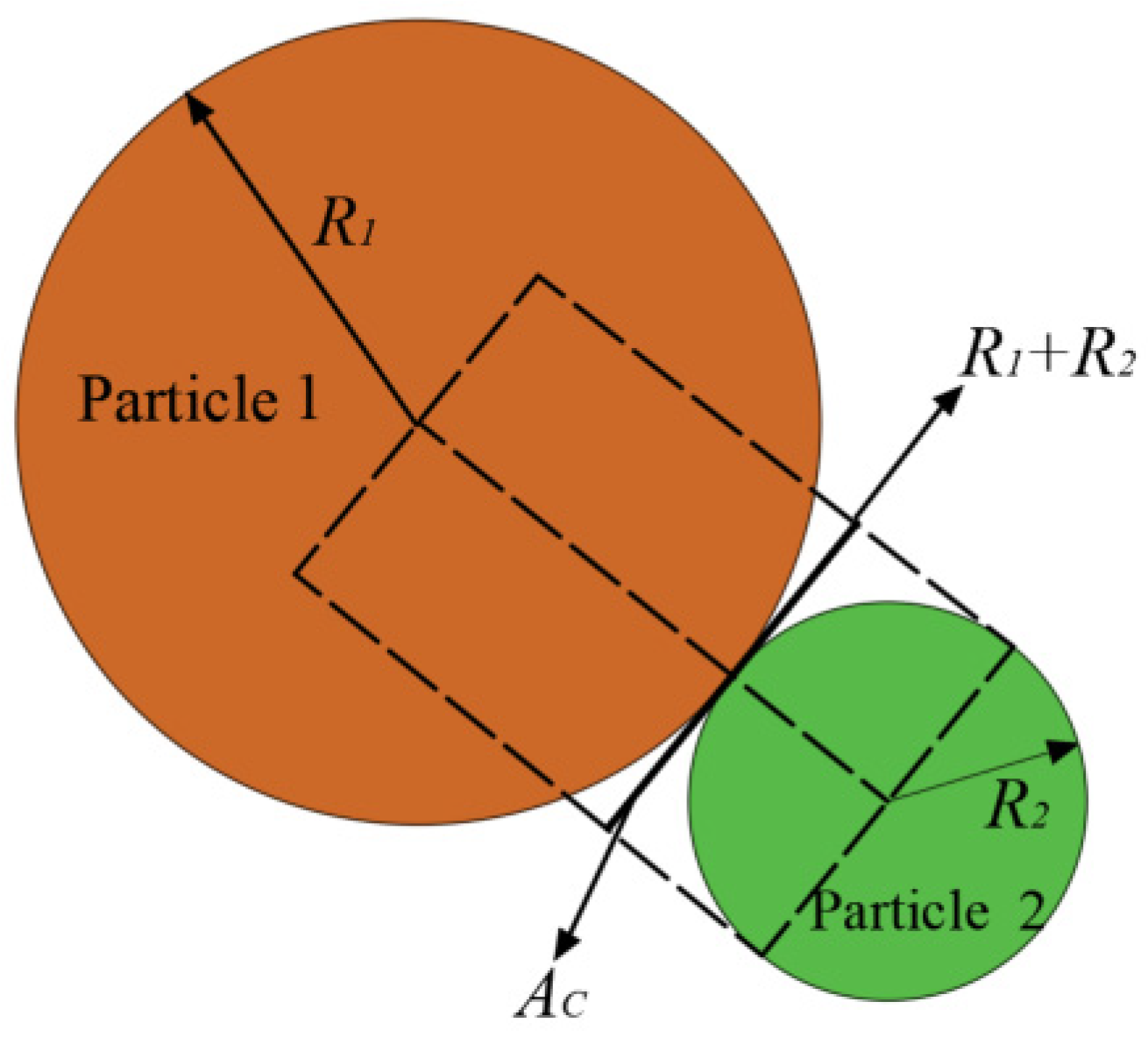
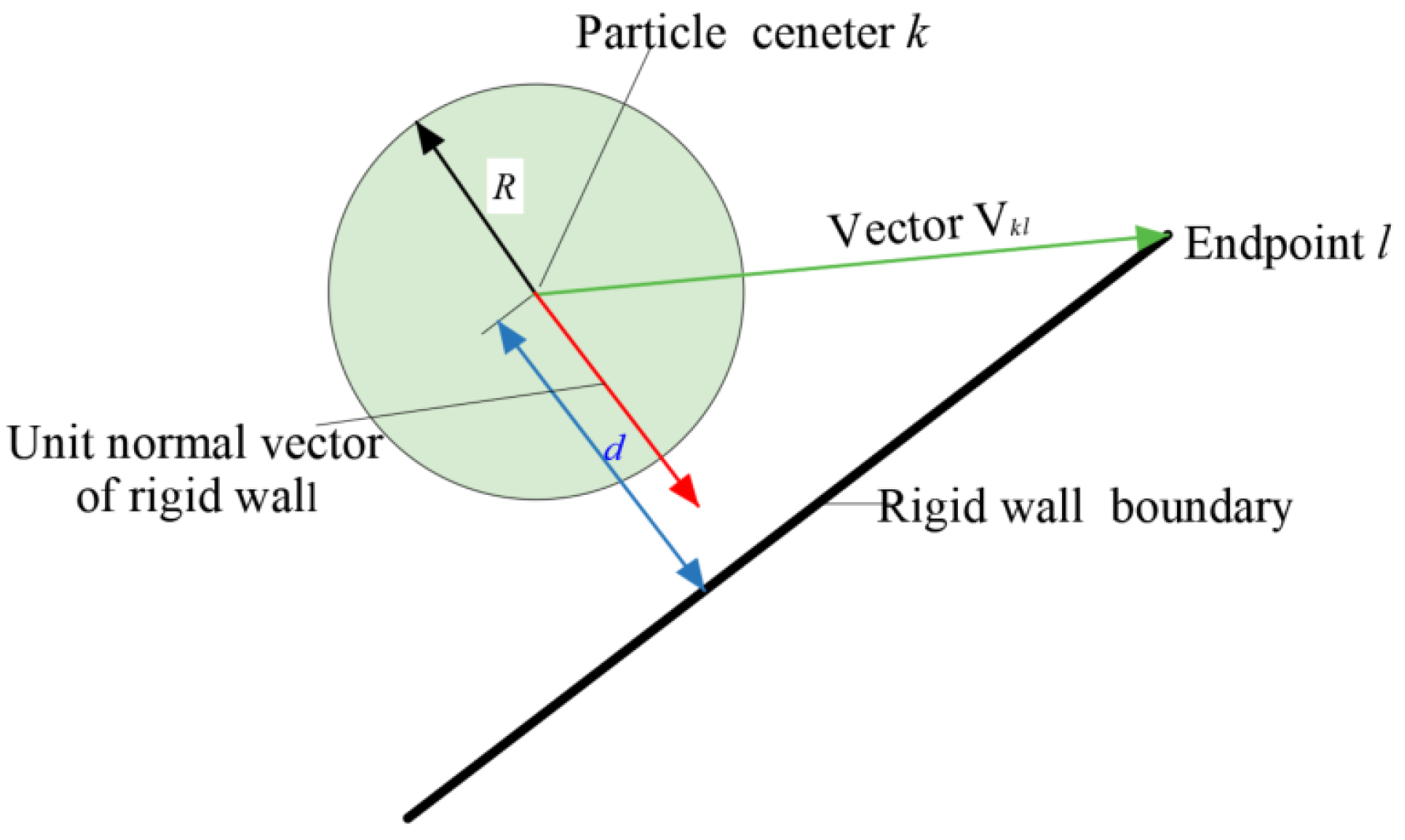
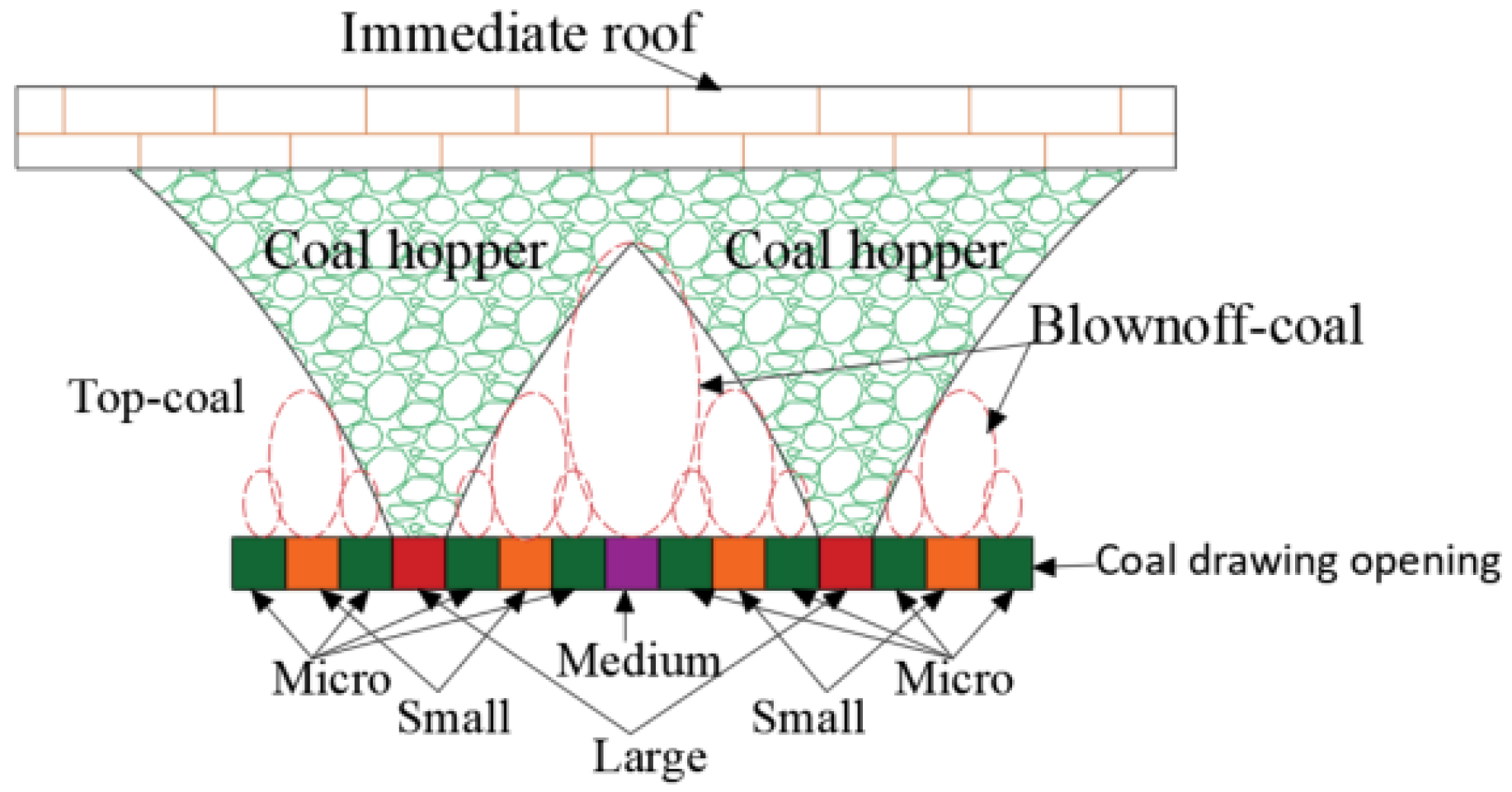

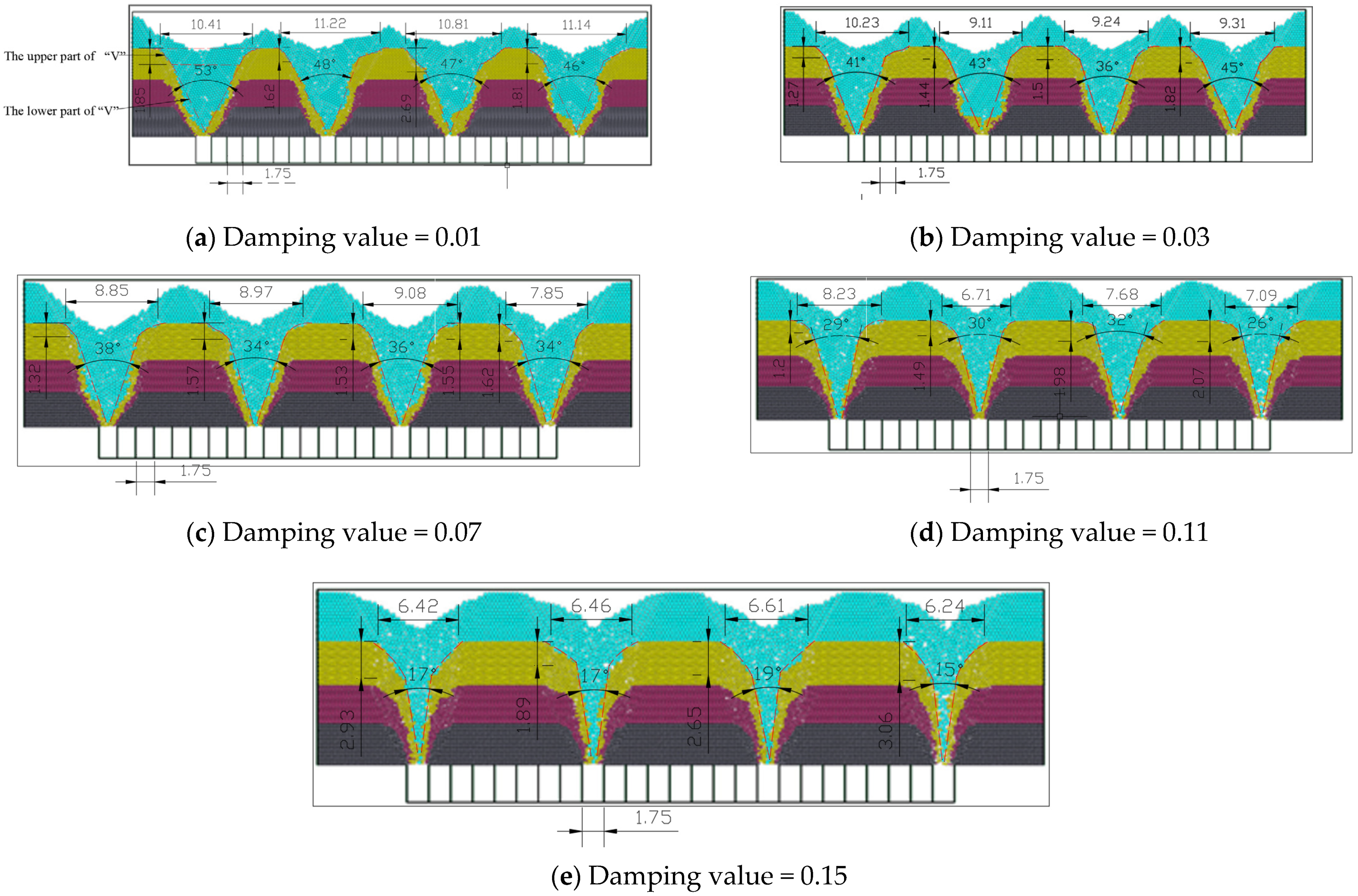

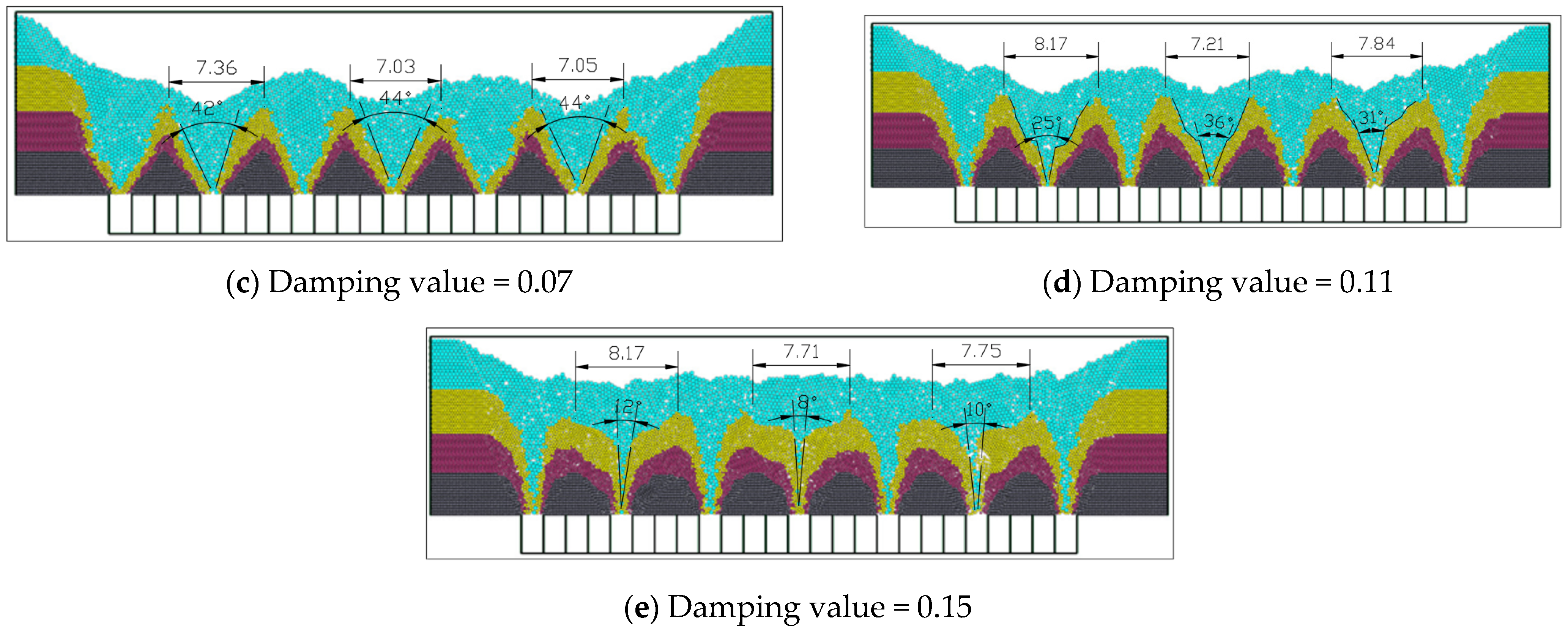
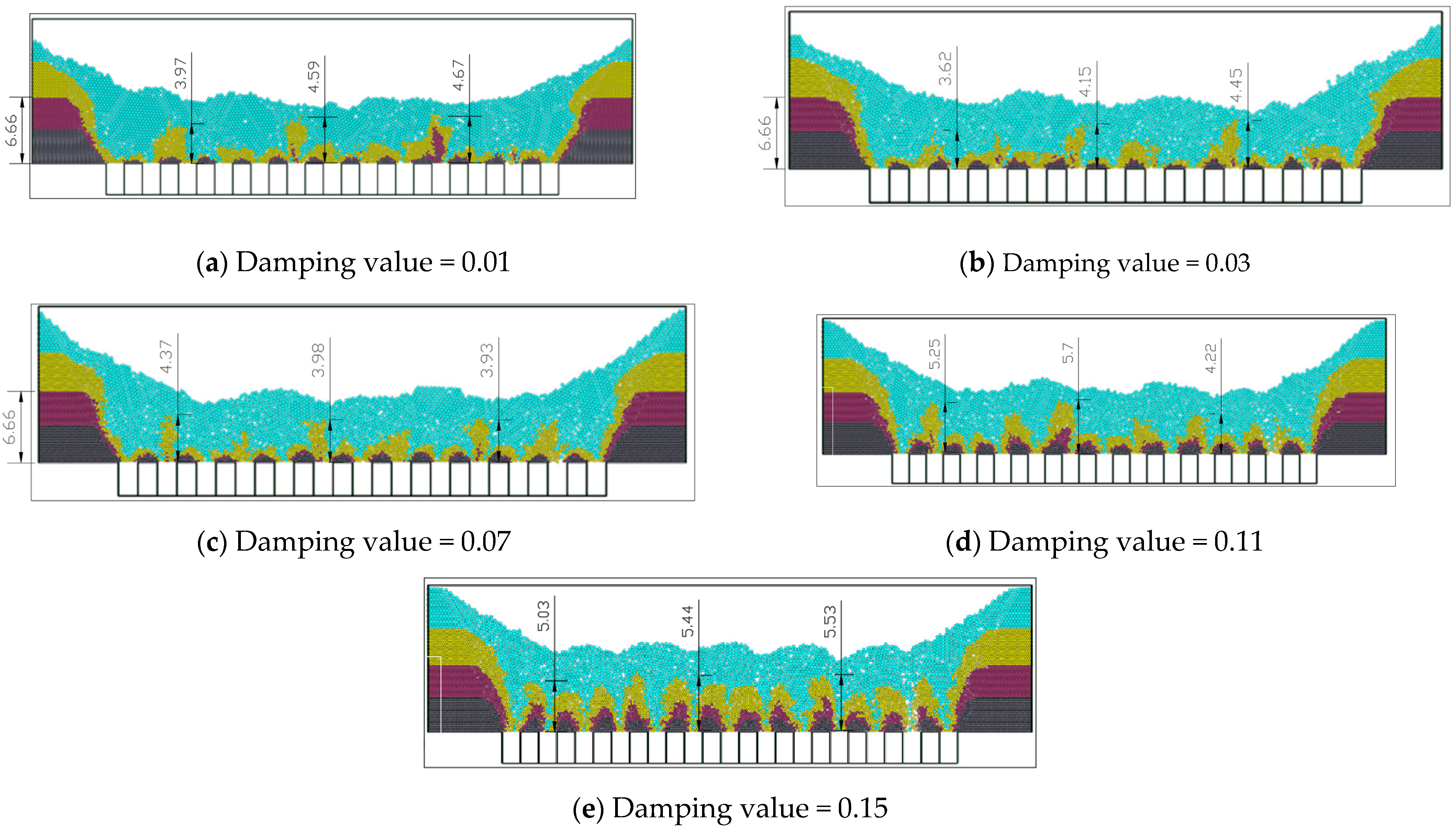
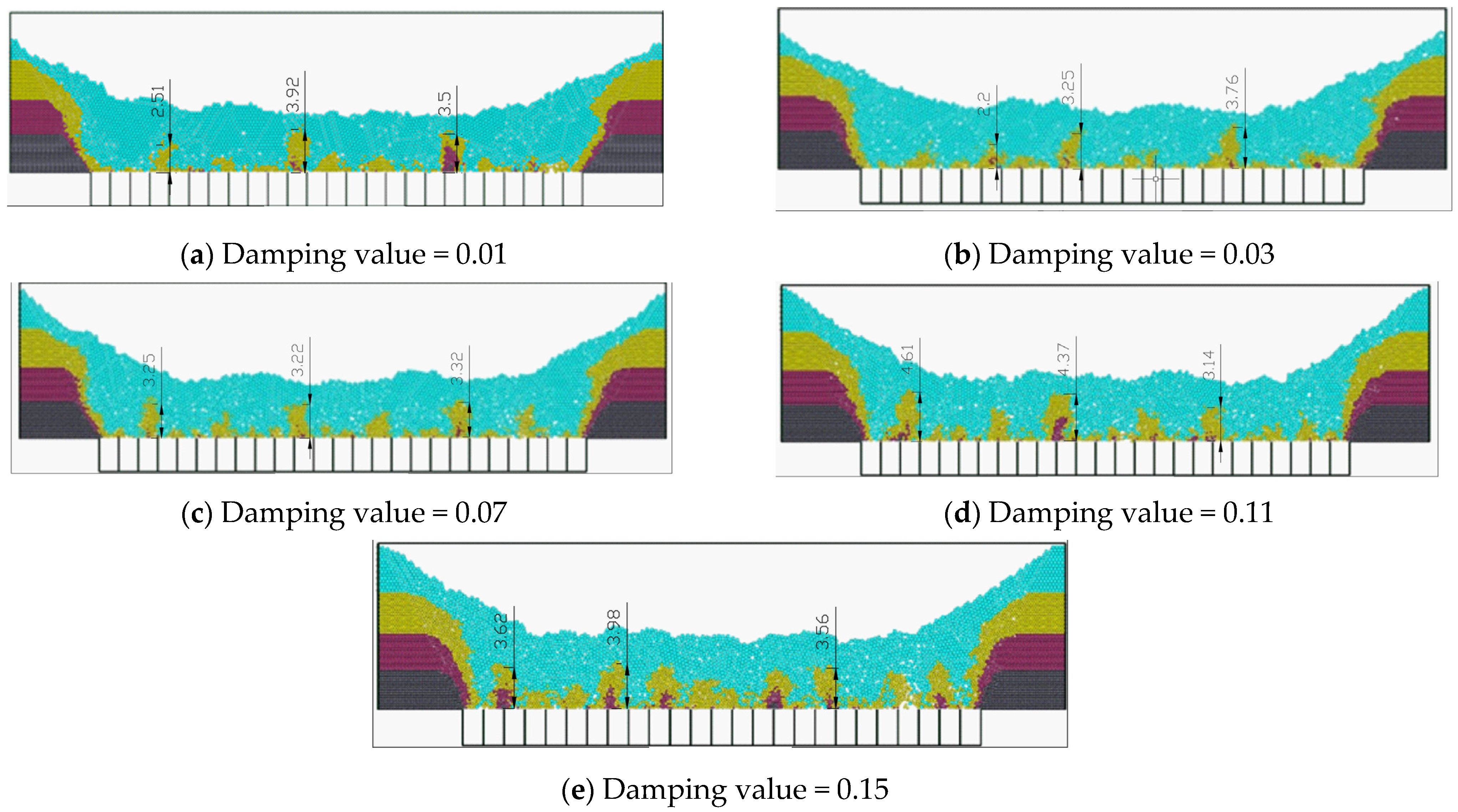

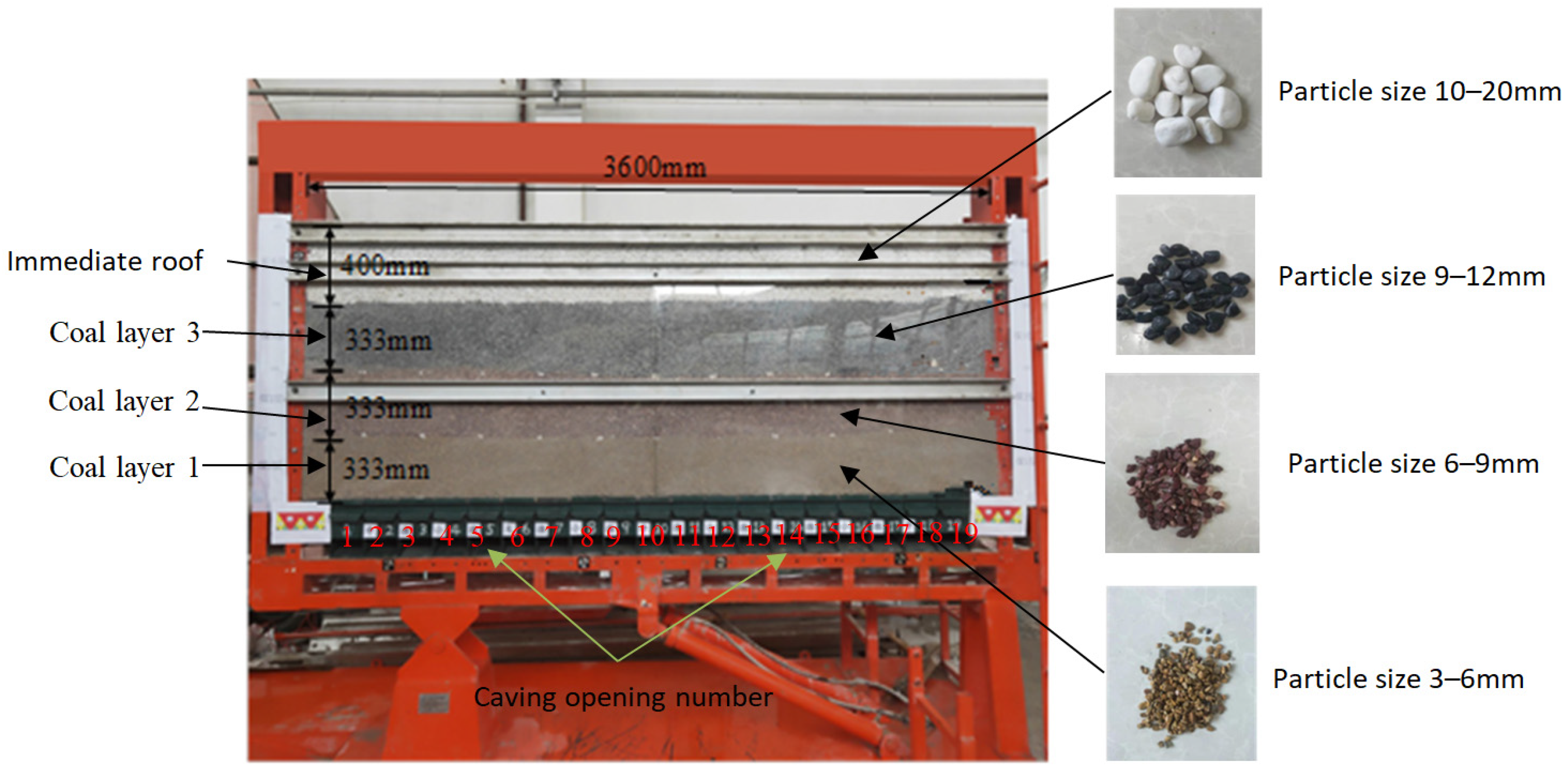
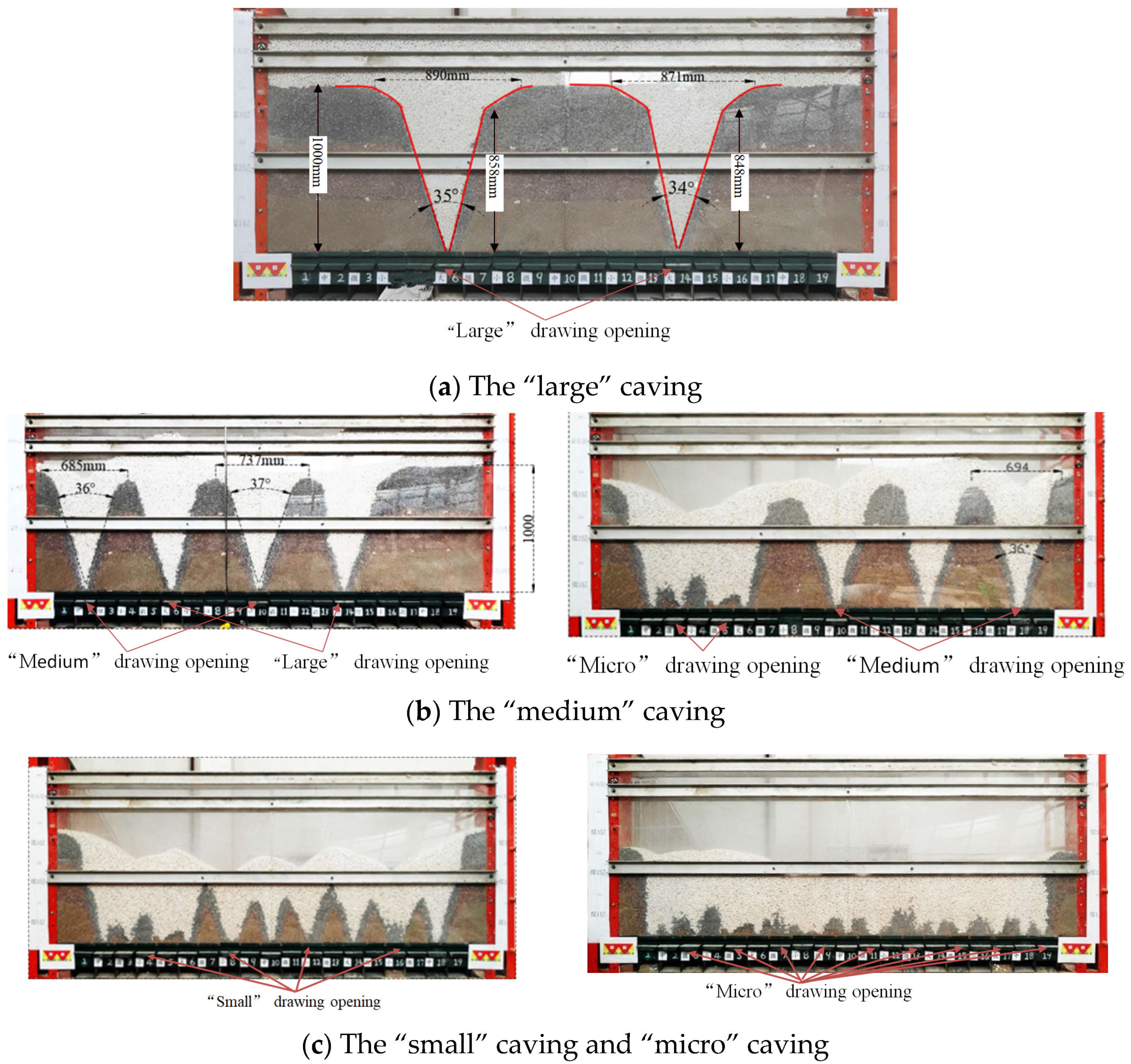
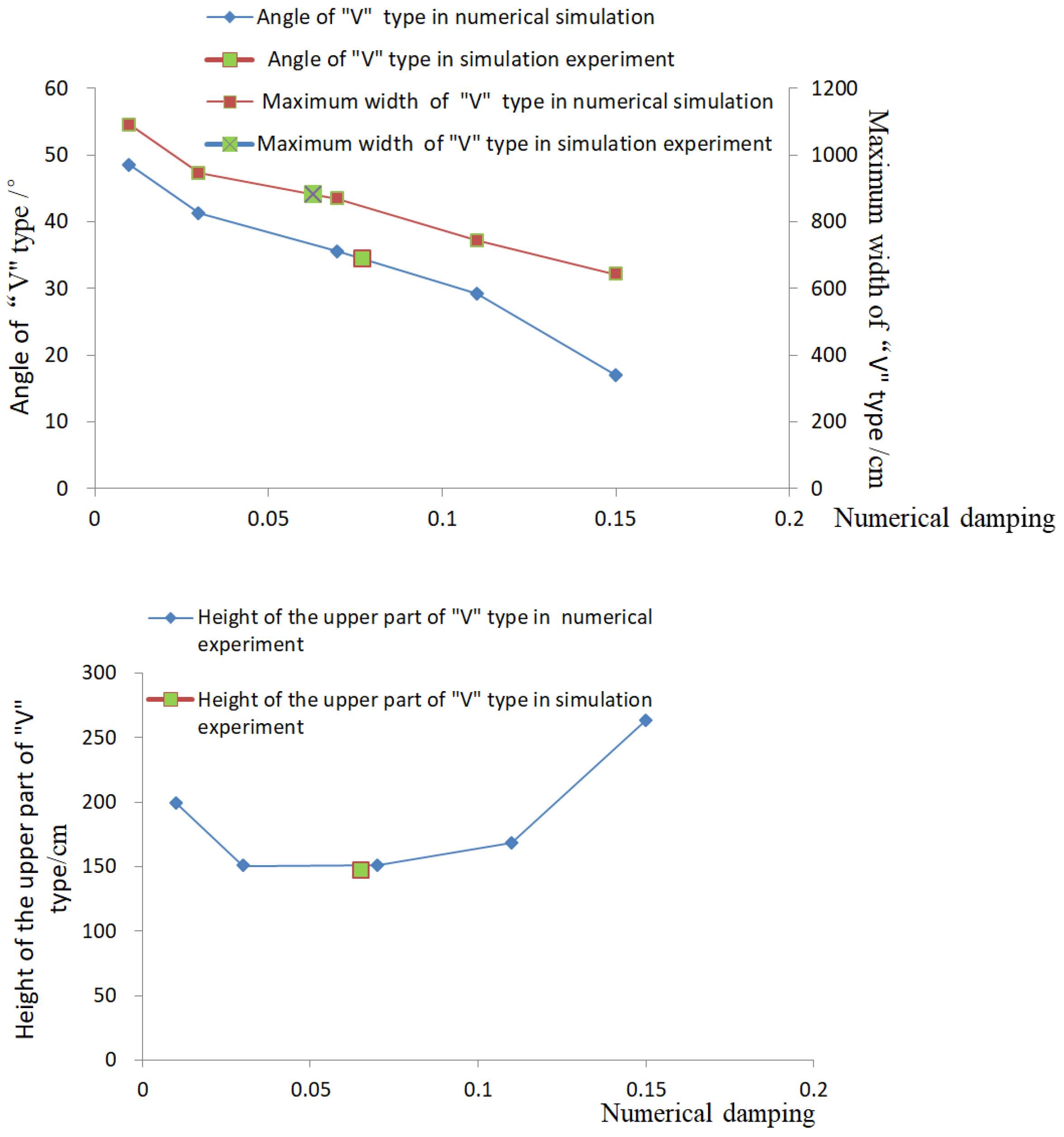
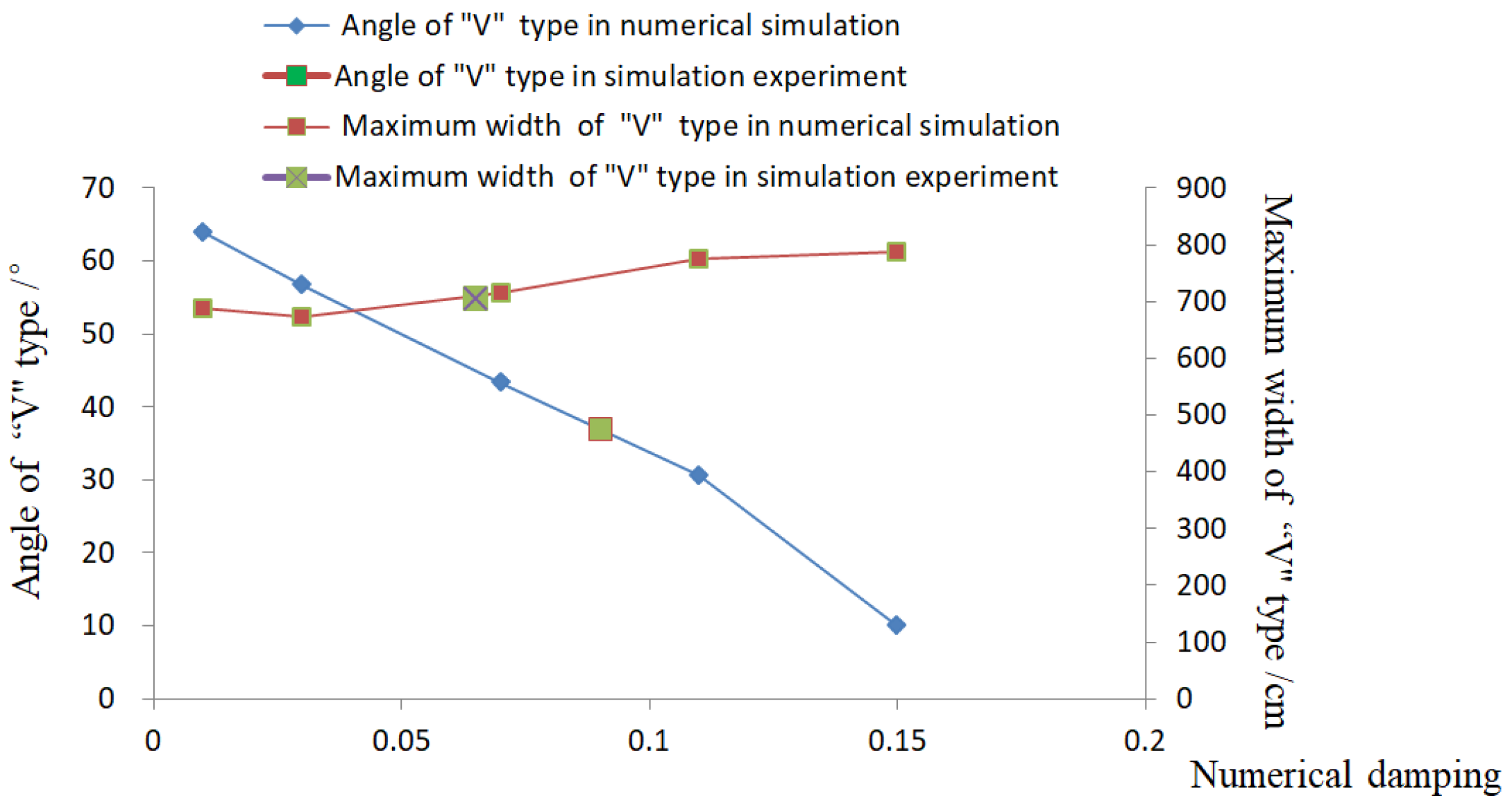
| Rock Layer Type | Density/(kg/m3) | Elastic Modulus/GPa | Poisson’s Ratio | Tensile Strength/MPa | Cohesion/MPa | Internal Friction/° |
|---|---|---|---|---|---|---|
| Coal Seams | 1364 | 2 | 0.27 | 0 | 0 | 32.65 |
| Immediate Roof | 2552 | 10 | 0.1 | 0 | 0 | 31.24 |
| Top-Coal Drawing Sequence | Hydraulic Support Number |
|---|---|
| Level 1 or Large | 1#; 9#; 17#; 25# |
| Level 2 or Medium | 5#; 13#; 21# |
| Level 3 or Small | 3#; 7#; 11#; 15#; 19#; 23# |
| Level 4 or Micro | 2#; 4#; 6#; 8#; 10#; 12#; 14#; 16#; 18#; 20#; 22#; 24# |
| Damping Value | Hydraulic Support Number | The Angle of ‘V’ (°) | Average Angle of ‘V’ (°) | Maximum Influence Width of ‘V’ (m) | Average Maximum Influence Width of ‘V’ (m) | Upper Height of ‘V’ (m) | Upper Average Height of ‘V’ (m) |
|---|---|---|---|---|---|---|---|
| 0.01 | 1# | 53 | 48.5 | 10.41 | 10.90 | 1.85 | 1.99 |
| 9# | 48 | 11.22 | 1.62 | ||||
| 17# | 47 | 10.81 | 2.69 | ||||
| 25# | 46 | 11.14 | 1.81 | ||||
| 0.03 | 1# | 41 | 41.25 | 10.23 | 9.47 | 1.27 | 1.51 |
| 9# | 43 | 9.11 | 1.44 | ||||
| 17# | 36 | 9.24 | 1.5 | ||||
| 25# | 45 | 9.31 | 1.82 | ||||
| 0.07 | 1# | 38 | 35.5 | 8.85 | 8.69 | 1.32 | 1.51 |
| 9# | 34 | 8.97 | 1.57 | ||||
| 17# | 36 | 9.08 | 1.53 | ||||
| 25# | 34 | 7.85 | 1.62 | ||||
| 0.11 | 1# | 29 | 29.25 | 8.23 | 7.43 | 1.2 | 1.69 |
| 9# | 30 | 6.71 | 1.49 | ||||
| 17# | 32 | 7.68 | 1.98 | ||||
| 25# | 26 | 7.09 | 2.07 | ||||
| 0.15 | 1# | 17 | 17 | 6.42 | 6.43 | 2.93 | 2.63 |
| 9# | 17 | 6.46 | 1.89 | ||||
| 17# | 19 | 6.61 | 2.65 | ||||
| 25# | 15 | 6.24 | 3.06 |
| Damping Value | Hydraulic Support Number | Angle of ‘V’ (°) | Average Angle of ‘V’ (°) | Maximum Influence Width of ‘V’ (m) | Average Maximum Influence Width of ‘V’ (m) |
|---|---|---|---|---|---|
| 0.01 | 5# | 33 | 64 | 6.3 | 6.88 |
| 13# | 76 | 7.53 | |||
| 21# | 83 | 6.81 | |||
| 0.03 | 5# | 54 | 56.7 | 6.1 | 6.72 |
| 13# | 52 | 6.73 | |||
| 21# | 64 | 7.34 | |||
| 0.07 | 5# | 42 | 43.3 | 7.36 | 7.15 |
| 13# | 44 | 7.03 | |||
| 21# | 44 | 7.05 | |||
| 0.11 | 5# | 25 | 30.7 | 8.17 | 7.74 |
| 13# | 36 | 7.21 | |||
| 21# | 31 | 7.84 | |||
| 0.15 | 5# | 12 | 10 | 8.17 | 7.88 |
| 13# | 8 | 7.71 | |||
| 21# | 10 | 7.75 |
| Coal Drawing Sequence | Type of Coal Drawing Opening | Hydraulic Support Number | Coal Port Size |
|---|---|---|---|
| 1 | Large | 6#; 14# | 100 mm |
| 2 | Medium | 2#; 10#; 18# | 100 mm |
| 3 | Small | 4#; 8#; 12#; 16# | 100 mm |
| 4 | Micro | 3#; 5#; 7#; 9#; 11#; 13#; 15#; 17#; 19# | 100 mm |
Publisher’s Note: MDPI stays neutral with regard to jurisdictional claims in published maps and institutional affiliations. |
© 2021 by the authors. Licensee MDPI, Basel, Switzerland. This article is an open access article distributed under the terms and conditions of the Creative Commons Attribution (CC BY) license (https://creativecommons.org/licenses/by/4.0/).
Share and Cite
Li, H.; Li, D.; Zhang, W.; Li, H.; Wang, S.; Wang, H.; Xu, X.; Li, Z. Numerical Damping Calibration Study of Particle Element Method-Based Dynamic Relaxation Approach for Modeling Longwall Top-Coal Caving. Energies 2021, 14, 2348. https://doi.org/10.3390/en14092348
Li H, Li D, Zhang W, Li H, Wang S, Wang H, Xu X, Li Z. Numerical Damping Calibration Study of Particle Element Method-Based Dynamic Relaxation Approach for Modeling Longwall Top-Coal Caving. Energies. 2021; 14(9):2348. https://doi.org/10.3390/en14092348
Chicago/Turabian StyleLi, Hongbin, Dongyin Li, Weiyu Zhang, Huamin Li, Shen Wang, Hao Wang, Xiaokai Xu, and Zhenfeng Li. 2021. "Numerical Damping Calibration Study of Particle Element Method-Based Dynamic Relaxation Approach for Modeling Longwall Top-Coal Caving" Energies 14, no. 9: 2348. https://doi.org/10.3390/en14092348
APA StyleLi, H., Li, D., Zhang, W., Li, H., Wang, S., Wang, H., Xu, X., & Li, Z. (2021). Numerical Damping Calibration Study of Particle Element Method-Based Dynamic Relaxation Approach for Modeling Longwall Top-Coal Caving. Energies, 14(9), 2348. https://doi.org/10.3390/en14092348





